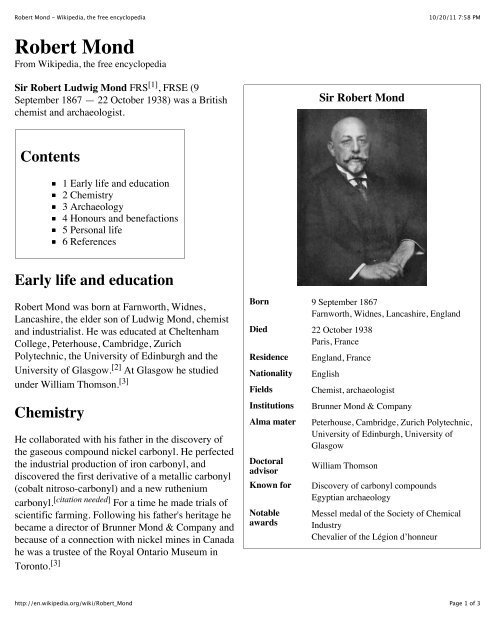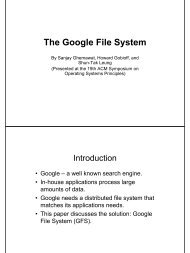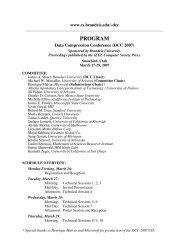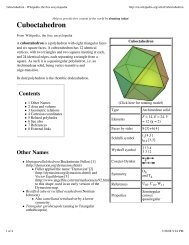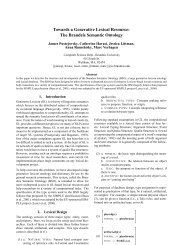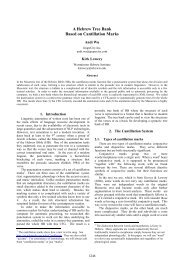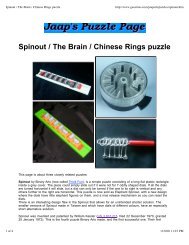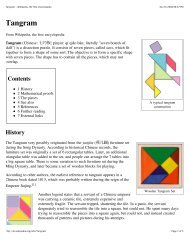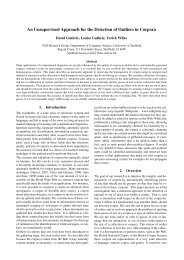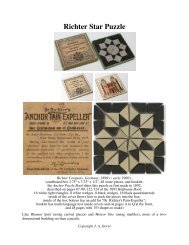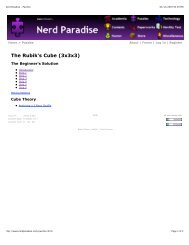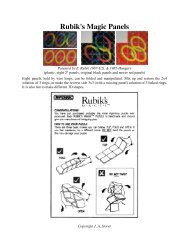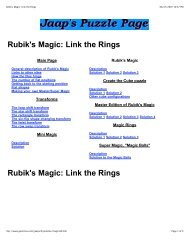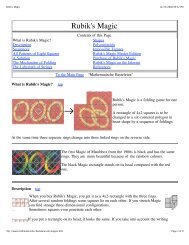Robert Mond - Wikipedia, the free encyclopedia
Robert Mond - Wikipedia, the free encyclopedia
Robert Mond - Wikipedia, the free encyclopedia
Create successful ePaper yourself
Turn your PDF publications into a flip-book with our unique Google optimized e-Paper software.
<strong>Robert</strong> <strong>Mond</strong> - <strong>Wikipedia</strong>, <strong>the</strong> <strong>free</strong> <strong>encyclopedia</strong><br />
<strong>Robert</strong> <strong>Mond</strong><br />
From <strong>Wikipedia</strong>, <strong>the</strong> <strong>free</strong> <strong>encyclopedia</strong><br />
Sir <strong>Robert</strong> Ludwig <strong>Mond</strong> FRS [1] , FRSE (9<br />
September 1867 — 22 October 1938) was a British<br />
chemist and archaeologist.<br />
Contents<br />
1 Early life and education<br />
2 Chemistry<br />
3 Archaeology<br />
4 Honours and benefactions<br />
5 Personal life<br />
6 References<br />
Early life and education<br />
<strong>Robert</strong> <strong>Mond</strong> was born at Farnworth, Widnes,<br />
Lancashire, <strong>the</strong> elder son of Ludwig <strong>Mond</strong>, chemist<br />
and industrialist. He was educated at Cheltenham<br />
College, Peterhouse, Cambridge, Zurich<br />
Polytechnic, <strong>the</strong> University of Edinburgh and <strong>the</strong><br />
University of Glasgow. [2] At Glasgow he studied<br />
under William Thomson. [3]<br />
Chemistry<br />
He collaborated with his fa<strong>the</strong>r in <strong>the</strong> discovery of<br />
<strong>the</strong> gaseous compound nickel carbonyl. He perfected<br />
<strong>the</strong> industrial production of iron carbonyl, and<br />
discovered <strong>the</strong> first derivative of a metallic carbonyl<br />
(cobalt nitroso-carbonyl) and a new ru<strong>the</strong>nium<br />
carbonyl. [citation needed] For a time he made trials of<br />
scientific farming. Following his fa<strong>the</strong>r's heritage he<br />
became a director of Brunner <strong>Mond</strong> & Company and<br />
because of a connection with nickel mines in Canada<br />
he was a trustee of <strong>the</strong> Royal Ontario Museum in<br />
Toronto. [3]<br />
http://en.wikipedia.org/wiki/<strong>Robert</strong>_<strong>Mond</strong><br />
Sir <strong>Robert</strong> <strong>Mond</strong><br />
10/20/11 7:58 PM<br />
Born 9 September 1867<br />
Farnworth, Widnes, Lancashire, England<br />
Died 22 October 1938<br />
Paris, France<br />
Residence England, France<br />
Nationality English<br />
Fields Chemist, archaeologist<br />
Institutions Brunner <strong>Mond</strong> & Company<br />
Alma mater Peterhouse, Cambridge, Zurich Polytechnic,<br />
University of Edinburgh, University of<br />
Glasgow<br />
Doctoral<br />
advisor<br />
William Thomson<br />
Known for Discovery of carbonyl compounds<br />
Egyptian archaeology<br />
Notable<br />
awards<br />
Messel medal of <strong>the</strong> Society of Chemical<br />
Industry<br />
Chevalier of <strong>the</strong> Légion d’honneur<br />
Page 1 of 3
<strong>Robert</strong> <strong>Mond</strong> - <strong>Wikipedia</strong>, <strong>the</strong> <strong>free</strong> <strong>encyclopedia</strong><br />
Archaeology<br />
http://en.wikipedia.org/wiki/<strong>Robert</strong>_<strong>Mond</strong><br />
10/20/11 7:58 PM<br />
He <strong>the</strong>n took an interest in Egyptian archaeology and worked with some of <strong>the</strong> major archaeologists of <strong>the</strong> time,<br />
including Percy Newberry, Howard Carter, Arthur Weigall and Alan Gardiner. With <strong>the</strong> last named he worked<br />
on <strong>the</strong> Theban necropolis. After World War I he was involved with <strong>the</strong> preservation of <strong>the</strong> tomb of Ramesses.<br />
He built up a considerable collection of artefacts which he bequea<strong>the</strong>d to <strong>the</strong> British Museum. He also<br />
performed archaeological work in Palestine, France and <strong>the</strong> Channel Islands and assisted in <strong>the</strong> foundation of a<br />
British School of Archaeology in Jerusalem. <strong>Robert</strong> <strong>Mond</strong> also took an interest in model soldiers building up a<br />
collection of 900 figures representing all <strong>the</strong> regiments in Napoleon's army. [3]<br />
Honours and benefactions<br />
<strong>Mond</strong> helped convert a house in Paris into <strong>the</strong> Maison de la Chimie which supported <strong>the</strong> work of chemistry in<br />
France and he was a benefactor of <strong>the</strong> British Institute in Paris. He also made large benefactions to <strong>the</strong><br />
universities of Liverpool, Manchester and Toronto.<br />
He was knighted in 1932. He received numerous honours including <strong>the</strong> honorary degrees of LL.D from <strong>the</strong><br />
universities of Liverpool and Toronto, and D.Sc from <strong>the</strong> University of London. He was made president of <strong>the</strong><br />
Faraday Society (1930–1932) [4][5] and was awarded <strong>the</strong> Messel medal of <strong>the</strong> Society of Chemical Industry. He<br />
was elected Fellow of <strong>the</strong> Royal Society of Edinburgh and Fellow of <strong>the</strong> Royal Society [1] . In France he became<br />
Chevalier of <strong>the</strong> Légion d’honneur and a member of <strong>the</strong> Académie des Inscriptions et Belles-Lettres, <strong>the</strong>reby<br />
joining <strong>the</strong> Institut de France. He was elected president of <strong>the</strong> Société de Chimie. [3]<br />
Personal life<br />
<strong>Robert</strong> <strong>Mond</strong> married twice. In 1898 he married Helen Levis and <strong>the</strong>y had two daughters but Helen died in<br />
1905, following <strong>the</strong> birth of <strong>the</strong>ir second daughter (born in 1901). In her memory <strong>Mond</strong> founded <strong>the</strong> Infants'<br />
Hospital in Vincent Square, London. In 1922 he married Marie-Louise Guggenheim (née Le Manach) of Belle-<br />
Île-en-Terre, Brittany and following this spent more of his life in France. He died in Paris, was cremated at <strong>the</strong><br />
Père Lachaise Cemetery and his ashes were buried at his home at Belle-Île-en-Terre. [3]<br />
References<br />
1. ^ a b Thorpe, J. F. (1939). "Sir <strong>Robert</strong> <strong>Mond</strong>. 1867-1938". Obituary Notices of Fellows of <strong>the</strong> Royal Society 2 (7): 627.<br />
doi:10.1098/rsbm.1939.0023 (http://dx.doi.org/10.1098%2Frsbm.1939.0023) .<br />
2. ^ <strong>Mond</strong>, <strong>Robert</strong> (http://venn.lib.cam.ac.uk/cgi-bin/search.pl?<br />
sur=&suro=c&fir=&firo=c&cit=&cito=c&c=all&tex=MNT885RL&sye=&eye=&col=all&maxcount=50) in Venn, J. &<br />
J. A., Alumni Cantabrigienses, Cambridge University Press, 10 vols, 1922–1958.<br />
3. ^ a b c d e Greenaway, Frank, '<strong>Mond</strong> family (per. 1867–1973)' (http://www.oxforddnb.com/view/article/51124) , Oxford<br />
Dictionary of National Biography, Oxford University Press, 2004, accessed March 9, 2007.<br />
4. ^ The Faraday Society 1903 to 1938 (http://www.rsc.org/AboutUs/History/rscpresidents/FS1903to1938.asp) . Royal<br />
Society of Chemistry<br />
5. ^ Anonymous (1938). "Obituary". Trans. Faraday Soc. 34: 1369–1370. doi:10.1039/TF9383401369<br />
Page 2 of 3
<strong>Robert</strong> <strong>Mond</strong> - <strong>Wikipedia</strong>, <strong>the</strong> <strong>free</strong> <strong>encyclopedia</strong><br />
(http://dx.doi.org/10.1039%2FTF9383401369) .<br />
Retrieved from "http://en.wikipedia.org/w/index.php?title=<strong>Robert</strong>_<strong>Mond</strong>&oldid=448333217"<br />
Categories: 1867 births 1938 deaths British chemists British archaeologists British Jews<br />
http://en.wikipedia.org/wiki/<strong>Robert</strong>_<strong>Mond</strong><br />
10/20/11 7:58 PM<br />
Jewish scientists British knights Commandeurs of <strong>the</strong> Légion d'honneur Fellows of <strong>the</strong> Royal Society<br />
Fellows of <strong>the</strong> Royal Society of Edinburgh English philanthropists<br />
Members of <strong>the</strong> Académie des Inscriptions et Belles-Lettres Old Cheltonians<br />
Alumni of Peterhouse, Cambridge Alumni of <strong>the</strong> University of Edinburgh<br />
Alumni of <strong>the</strong> University of Glasgow People associated with <strong>the</strong> University of London Institute in Paris<br />
People from Widnes<br />
This page was last modified on 4 September 2011 at 03:58.<br />
Text is available under <strong>the</strong> Creative Commons Attribution-ShareAlike License; additional terms may<br />
apply. See Terms of use for details.<br />
<strong>Wikipedia</strong>® is a registered trademark of <strong>the</strong> Wikimedia Foundation, Inc., a non-profit organization.<br />
Page 3 of 3


